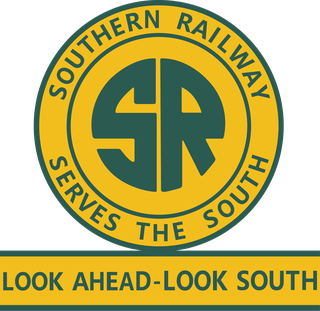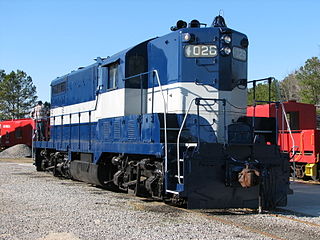The Tennessee and Pacific Railroad was a 19th-century American company that operated a rail line from Lebanon, Tennessee, to Nashville, Tennessee.

The United States of America (USA), commonly known as the United States or America, is a country composed of 50 states, a federal district, five major self-governing territories, and various possessions. At 3.8 million square miles, the United States is the world's third or fourth largest country by total area and is slightly smaller than the entire continent of Europe's 3.9 million square miles. With a population of over 327 million people, the U.S. is the third most populous country. The capital is Washington, D.C., and the largest city by population is New York. Forty-eight states and the capital's federal district are contiguous in North America between Canada and Mexico. The State of Alaska is in the northwest corner of North America, bordered by Canada to the east and across the Bering Strait from Russia to the west. The State of Hawaii is an archipelago in the mid-Pacific Ocean. The U.S. territories are scattered about the Pacific Ocean and the Caribbean Sea, stretching across nine official time zones. The extremely diverse geography, climate, and wildlife of the United States make it one of the world's 17 megadiverse countries.
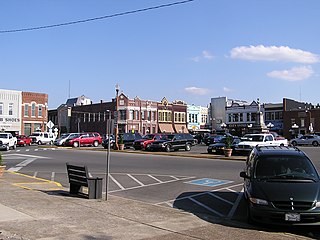
Lebanon is the county seat of Wilson County, Tennessee, United States.

Nashville is the capital and most populous city of the U.S. state of Tennessee. The city is the county seat of Davidson County and is located on the Cumberland River. The city's population ranks 24th in the U.S. According to 2017 estimates from the U.S. Census Bureau, the total consolidated city-county population stood at 691,243. The "balance" population, which excludes semi-independent municipalities within Davidson County, was 667,560 in 2017.
The state of Tennessee chartered the railroad on May 24, 1866. The original plans were to build a line from Knoxville eastward through Lebanon, Nashville, and Memphis to Jackson, Mississippi, where it would interconnect with westward-leading railroads to the Pacific Coast. Hauling coal from the nearby Cumberland Mountains to western markets was an important intended source of operation income, as well as from passenger service and produce and freight hauls.

Tennessee is a state located in the southeastern region of the United States. Tennessee is the 36th largest and the 16th most populous of the 50 United States. Tennessee is bordered by Kentucky to the north, Virginia to the northeast, North Carolina to the east, Georgia, Alabama, and Mississippi to the south, Arkansas to the west, and Missouri to the northwest. The Appalachian Mountains dominate the eastern part of the state, and the Mississippi River forms the state's western border. Nashville is the state's capital and largest city, with a 2017 population of 667,560. Tennessee's second largest city is Memphis, which had a population of 652,236 in 2017.

Knoxville is a city in the U.S. state of Tennessee, and the county seat of Knox County. The city had an estimated population of 186,239 in 2016 and a population of 178,874 as of the 2010 census, making it the state's third largest city in the state after Nashville and Memphis. Knoxville is the principal city of the Knoxville Metropolitan Statistical Area, which, in 2016, was 868,546, up 0.9 percent, or 7,377 people, from to 2015. The KMSA is, in turn, the central component of the Knoxville-Sevierville-La Follette Combined Statistical Area, which, in 2013, had a population of 1,096,961.

Memphis is a city located along the Mississippi River in southwestern Shelby County, Tennessee, United States. The 2017 city population was 652,236, making Memphis the 25th largest city in the United States. Greater Memphis is the 42nd largest metropolitan area in the United States, with a population of 1,348,260 in 2017. The city is the anchor of West Tennessee and the greater Mid-South region, which includes portions of neighboring Arkansas and Mississippi. Memphis is the seat of Shelby County, the most populous county in Tennessee. As one of the most historic and cultural cities of the southern United States, the city features a wide variety of landscapes and distinct neighborhoods.
Among the early investors and executives was former Confederate general George Maney, who would serve for nine years as the president of the Tennessee & Pacific, starting in 1868 when he succeeded the late James D. B. DeBow, the well known publisher of DeBow's Review .

The Confederate States Army (C.S.A.) was the military land force of the Confederate States of America (Confederacy) during the American Civil War (1861–1865), fighting against the United States forces. On February 28, 1861, the Provisional Confederate Congress established a provisional volunteer army and gave control over military operations and authority for mustering state forces and volunteers to the newly chosen Confederate president, Jefferson Davis. Davis was a graduate of the U.S. Military Academy, and colonel of a volunteer regiment during the Mexican–American War. He had also been a United States Senator from Mississippi and U.S. Secretary of War under President Franklin Pierce. On March 1, 1861, on behalf of the Confederate government, Davis assumed control of the military situation at Charleston, South Carolina, where South Carolina state militia besieged Fort Sumter in Charleston harbor, held by a small U.S. Army garrison. By March 1861, the Provisional Confederate Congress expanded the provisional forces and established a more permanent Confederate States Army.

George Earl Maney was an American soldier, politician, railroad executive and diplomat. He was a general in the Confederate States Army during the American Civil War and a postbellum U.S. ambassador to Colombia, Bolivia, Uruguay, and Paraguay.
Plagued by difficulties in raising enough financing, the company finally began construction in June 1869 of the 29-mile line between Lebanon and Nashville. Funds were generated to commission the Rogers Locomotive and Machine Works to manufacture two 4-4-0 locomotives for the new T&P, which were delivered in 1870. These were named the "Wilson County" and the "J.D.B. DeBow." [1]
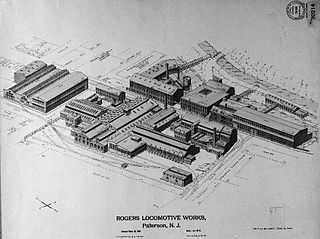
Rogers Locomotive and Machine Works was a 19th-century manufacturer of railroad steam locomotives based in Paterson, in Passaic County, New Jersey, in the United States. It built more than six thousand steam locomotives for railroads around the world. Most railroads in 19th-century United States rostered at least one Rogers-built locomotive. The company's most famous product was a locomotive named The General, built in December 1855, which was one of the principals of the Great Locomotive Chase of the American Civil War.

Under the Whyte notation for the classification of steam locomotives by wheel arrangement, 4-4-0 represents the arrangement of four leading wheels on two axles, usually in a leading bogie, four powered and coupled driving wheels on two axles, and no trailing wheels. Almost every major railroad that operated in North America in the first half of the 19th century owned and operated locomotives of this type. Due to the large number of the type that were produced and used in the United States, the 4-4-0 is most commonly known as the American type, but the type subsequently also became popular in the United Kingdom, where large numbers were produced.

A locomotive or engine is a rail transport vehicle that provides the motive power for a train. If a locomotive is capable of carrying a payload, it is usually rather referred to as multiple units, motor coaches, railcars or power cars; the use of these self-propelled vehicles is increasingly common for passenger trains, but rare for freight.
The segment opened in September 1871 in time to convey passengers to the Wilson County Fair. Headquartered in Lebanon, the fledgling railroad erected a sprawling Victorian-style passenger and freight station, combined with the general offices. Major cargo from local farmers included lumber, butter, flour, and other agricultural products which were shipped to markets in Nashville, where another station house was erected in 1872.

Wilson County is a county located in the U.S. state of Tennessee. As of the 2010 census, the population was 113,993. Its county seat is Lebanon. The largest city is Mt. Juliet.

Victorian architecture is a series of architectural revival styles in the mid-to-late 19th century. Victorian refers to the reign of Queen Victoria (1837–1901), called the Victorian era, during which period the styles known as Victorian were used in construction. However, many elements of what is typically termed "Victorian" architecture did not become popular until later in Victoria's reign. The styles often included interpretations and eclectic revivals of historic styles. The name represents the British and French custom of naming architectural styles for a reigning monarch. Within this naming and classification scheme, it followed Georgian architecture and later Regency architecture, and was succeeded by Edwardian architecture.
However, the financial problems resurfaced and management could not repay the railroad company's debts. In 1877, the state revoked the charter and seized the Tennessee & Pacific. The company and its assets were sold on March 1 to the Nashville, Chattanooga and St. Louis Railway. The T&P stayed in operation under its old name until 1888, when it became the NC&StL Lebanon Branch. Passenger service continued on the old line until 1935, when the last train departed Lebanon. [2]
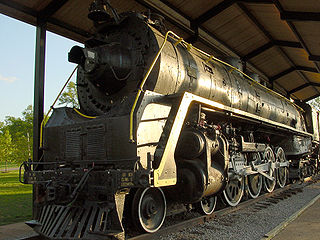
The Nashville, Chattanooga and St. Louis Railway was a railway company operating in the southern United States in Kentucky, Tennessee, Alabama and Georgia. It began as the Nashville and Chattanooga Railroad, chartered in Nashville in December 11, 1845, built to 5 ft gauge and was the first railway to operate in the state of Tennessee. By the turn of the twentieth century, the NC&StL grew into one of the most important railway systems in the southern United States.
